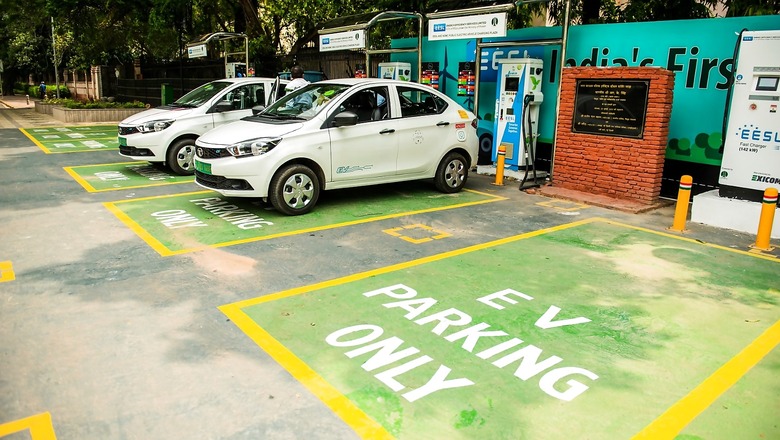
views
The onset of winter in Delhi coincides with degrading air quality. Along with other issues of stubble burning and pollution from crackers comes the major problem of air pollution. A study by Automotive Research Association of India (ARAI) and The Energy and Resources Institute (TERI) in 2018 estimated that motor vehicles are the primary source of pollutants within Delhi and contribute to about 40 per cent of PM2.5 emissions. Therefore, it is vital to clean the transport system to clean Delhi’s air.
In the late ‘90s, Delhi started the CNG programme to address transport emissions. By the start of 2005, more than 10,000 buses, 55,000 autorickshaws, 10,000 CNG taxis and cars and 5,000 minibuses were running on compressed natural gas (CNG) in Delhi. While shifting to CNG significantly impacted Delhi’s air quality, these gains were negated due to an exponential increase in motor vehicles. It became evident that what Delhi needed was a ‘zero emission’ transport system.
In August 2020, the Delhi government launched the Delhi Electric Vehicles (EV) Policy. The Policy, aimed at driving the transition to battery electric vehicles, sought that 25 per cent of the total new vehicle registrations by 2024 be electric. Delhi is not the first or the only state in India to develop an EV policy; most states have either notified or drafted their EV policies. But in the absence of stringent measures, there has been limited impact and EVs sales are still around 1.6 per cent at the national level.
In Delhi, this number has risen sharply to 9 per cent for September-November quarter in 2021. Now, that’s an exponential rise, given that EV registration was around 1 per cent in 2019-20. Here are three reasons why Delhi is becoming the EV capital of the country.
Innovation
Most state EV policies have focused on the ‘supply side’ approach, which encourages EV industries to manufacture in respective states. This is important because if the number of electric vehicles available in the market is less, their uptake would be impossible. However, the production of vehicles is also linked to their demand, which is where Delhi has innovated.
The city-state’s EV policy also focuses on demand generation for electric vehicles. The logic is simple — if there is enough demand for electric vehicles – the supply will increase automatically. Also, most state EV policies have struggled with implementation due to a lack of finances. Delhi has created a ‘State EV Fund’ to implement the EV policy. The fund includes contributions from various sources such as pollution cess, road tax, congestion fee and Environment Compensation Charge (ECC). The other innovation in Delhi’s EV policy is the measurable target. The target of 25 per cent of total new vehicle registrations by 2024 to be electric is specific, quantifiable, and timebound enough to hold the government accountable.
Collaboration
The manufacturing of electric vehicles employs a new technology altogether. EV adoption needs an ecosystem change which cannot be achieved by one agency or department alone. Various stakeholders must collaborate to achieve this transformation, and this is exactly what the Delhi government has done to operationalise the state’s EV policy.
Both the transport and power ministries are completely aligned with the Delhi EV policy, which is a welcome change, to accelerate EV adoption. The Delhi government has also brought in the Dialogue and Development Commission of Delhi (DDC-D) to tap into the expertise of various research institutes, which is again a tremendous collaborative step. In addition, consultations with Original Equipment Manufacturers (OEMs), banks, Non-Banking Financial Companies (NBFCs) etc. is a regular feature in Delhi that has further helped in underscoring the seriousness of the government’s effort towards electric mobility.
Implementation
It is often said that India has excellent policies and programmes, but their implementation is abysmal. The focus on ‘implementation’ is probably the biggest differentiator of Delhi’s EV policy. The Delhi government has set up a ‘State EV Cell’ under the transport department for helping with the implementation of the Delhi EV policy. The EV cell reports to the Transport Commissioner of Delhi and currently consists of officials from the transport department, Delhi Transport Infrastructure Development Corporation Limited (DTIDC) and independent consultants.
In addition, there is also a ‘Working Group’ that focuses on accelerating the roll-out of charging infrastructure. Apart from all these institutional set ups, reducing the cost of EVs by giving additional subsidies has dramatically helped in its uptake. The development of public charging facilities and the recently inaugurated single-window portal for setting up private charging stations are the other game-changers that are accelerating EV uptake in Delhi.
It is estimated that 90 per cent of transport emission in India comes from the road transport sector. Therefore, electrification of vehicles is not only a part of the solution to enhance air quality but is also a crucial tool for fighting climate change. Delhi’s push towards electric mobility has turned out to be a great success indicator. What is needed now is a continued focus on zero-emission vehicles. In addition, a similar approach by surrounding NCR cities like Noida, Gurugram and Ghaziabad would help create a much more significant impact.
Amit Bhatt is Director, Integrated Transport at World Resources Institute India (WRI India). The views expressed in this article are those of the author and do not represent the stand of this publication.
Read all the Latest Opinions here

















Comments
0 comment